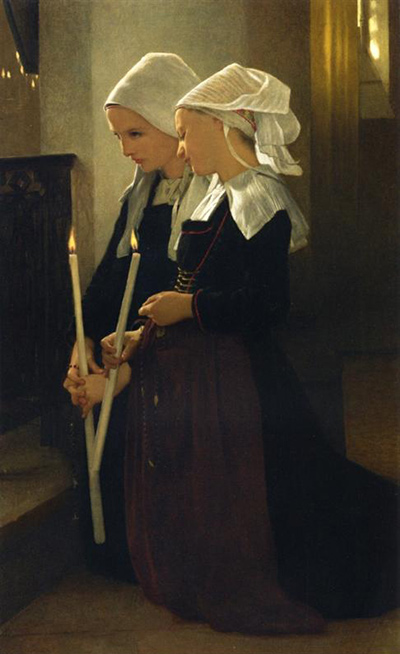William-Adolphe Bouguereau (1825-1905) painted many of his works in the Victorian ethos of the morally uplifting subject, that is, the image ennobling the person who viewed it. Prayer at Sainte Anne d’Auray (1869), the image of two young women kneeling in prayer, is within this tradition.
The title of the painting is the name of the basilica of Sainte-Anne-d’Auray, a major site of pilgrimage in Brittany, France. Legend has it that in 1625, a group of peasants followed a mysterious candle or torch to a field where it sank into the ground. Upon digging the patch of ground, the peasants found an old wooden statue that they believed to be of St Anne.
Eventually, the Bishop authorised the building of the basilica.
In Bouguereau’s painting, the candles that the women carry no doubt refer to the mystical light that the peasants saw. The clothing of the women, linen bonnets and collars over simple, black dresses, indicates that they too are peasants. The light that sheds upon their features creates a focal point, drawing out their inner purity and spirituality.
The painting suggests that it is faith that brings the subject closer to the divine, not high social class or fine clothes. Although Bouguereau was a nineteenth-century neoclassical painter, he employed the techniques of the seventeenth-century Baroque painters to tell his story.
The chief proponent of Baroque was Rembrandt van Rijn (1606-69). Following the essays into brilliant colour of the Renaissance artists, Rembrandt perfected the technique of tenebrism, that is, executing images of light emerging from darkness. Rembrandt also initiated the fashion for the collective portrait, a portrayal of two or more people engaged in a common activity.
The finest example of this is The Night Watch (1642), a group of socially-engaged men emerging from shadow into sunshine. As with the Rembrandt painting, Bouguereau’s women are individuals, not merely pious stereotypes. Like Rembrandt, Bouguereau renders subtle nuances of light by painting it in degrees. The wax candle stems and linens reflect the intense yellow of the flames.
This light grows paler as it moves further from its source, becoming a vapid luminescence on the wall behind the women. Bouguereau balances the image by repeating this brilliance on either side of the painting, the reflection in the gold altar ornament and the light from the window.




